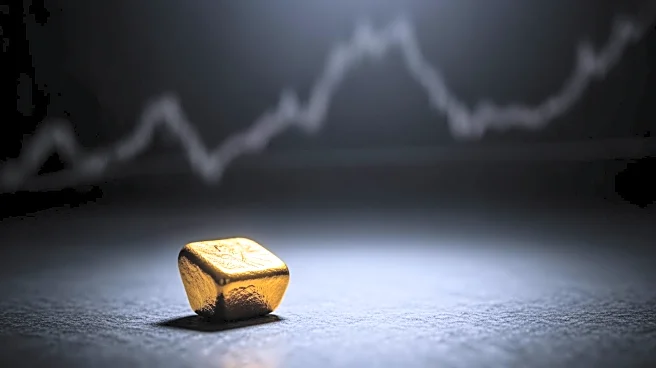What's Happening?
Gold has emerged as a preferred safe-haven asset amidst global economic turmoil, with prices reaching unprecedented levels. As of November 2025, geopolitical tensions, persistent inflation, and unpredictable
monetary policies have driven investors towards gold, resulting in record-breaking prices. The precious metal's value has soared to $4,456.54 per troy ounce, with projections suggesting further increases. This surge is attributed to heightened demand from retail investors, institutional players, and central banks, who are diversifying their reserves away from dollar-denominated assets. The appeal of gold is reinforced by its historical stability and intrinsic value, offering a hedge against inflation and a diversifier in volatile portfolios.
Why It's Important?
The rise in gold prices reflects broader economic uncertainties and a shift in investor sentiment towards tangible assets. Gold's performance highlights its role as a reliable store of value during times of crisis, providing stability in portfolios. This trend benefits gold mining companies, which are likely to see increased revenues and profit margins. Conversely, sectors reliant on consumer discretionary spending may face challenges as capital flows into safe havens. The sustained demand for gold also signals a growing skepticism towards fiat currencies, prompting central banks to diversify their reserves. This shift could have long-term implications for global financial systems and investment strategies.
What's Next?
Looking ahead, gold is expected to maintain its upward trajectory, driven by ongoing geopolitical instability and inflationary pressures. Analysts predict further price increases, with potential targets between $4,500 and $5,000 per troy ounce. Investors may continue to increase their allocation to gold, whether through physical bullion, ETFs, or shares in gold mining companies. Central banks' continued accumulation of gold reserves suggests a strategic long-term view of the metal as a foundational asset. However, potential short-term corrections could occur if geopolitical tensions ease or if central banks adopt hawkish stances.
Beyond the Headlines
Gold's current performance is indicative of broader industry trends and a shifting global financial order. The sustained demand for gold reflects a growing desire for tangible assets amidst unprecedented government debt levels and aggressive monetary easing cycles. This trend fits into a pattern of de-dollarization among certain central banks, seeking to mitigate geopolitical risks and currency volatility. The ripple effects extend to various sectors, with increased business for partners in the gold supply chain. Regulatory implications may arise if the surge in demand leads to concerns about market manipulation or calls for greater transparency.











